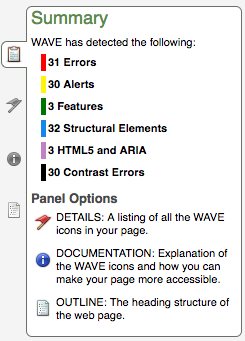ADA Compliance is quickly becoming a major concern for Credit Unions across the country. In this post, I'm going to break down what ADA compliance is, how it applies to credit union websites, how to tell if you're compliant, and what to do if you're not.
I'll continue to update this post as new information becomes available.
But before I dive in, let me begin with a disclaimer: we are not lawyers, are not claiming to be experts in this topic, and do not make the claim that by following our advice you will be protected from or more immune to any ADA lawsuit. What we can do is speak from the perspective of a digital marketing company who works with dozens of credit unions and has experience making credit union websites as ADA compliant as possible. This post is simply to share what we know and learn on this topic.
The information below is meant to get you started in understanding how ADA Compliance standards could impact credit union websites. You should ultimately consult with your web development company (or us) on how to make your particular website as ADA compliant as possible. We handle ADA compliance projects on a case by case basis. Your website platform and our ability to access that platform will ultimately dictate whether or not we can help you.
What Is ADA Compliance:
Essentially, this is about making websites as equally accessible to those with disabilities as those without disabilities. That is, undeniably, a good thing. Unfortunately, web developers didn’t think this way until the government said they had to, so now websites have a lot of cleaning up to do.
Here's the official language taken directly from ADA.gov:
“The Americans with Disabilities Act (ADA) generally requires that state and local governments provide qualified individuals with disabilities equal access to their programs, services, or activities unless doing so would fundamentally alter the nature of their programs, services, or activities or would impose an undue burden.
One way to help meet these requirements is to ensure that government websites have accessible features for people with disabilities…”
You can read the full document here.
How ADA Compliance Applies To Credit Union Websites:
Like any other website, there are several usability issues ADA Compliance looks for. Several of which are specific to the site code. If you’re not a web developer, it wouldn’t make any sense to you, so we won’t list everything here. But here’s a basic idea of what ADA Compliance could flag:
- contrasting colors are too alike
- clickable targets (links or images) are too close together
- not properly tagging images with “alt” text (the “alternative text” version of an image)
Addressing these issues can be as simple as adding additional code or as complex as redesigning your site’s layout.
To get your site as ADA Compliant as possible, you’ll need a web developer to address all the issues that go beyond the above.
How To Tell If You’re ADA Compliant:
Unfortunately, there is no government endorsed or supported tool to check ADA Compliance (that we know of). This means you have to rely on third party tools to check for the things considered ADA compliant or non-compliant.
Here are the tools and methods we use for testing ADA Compliance:
WAVE (in a recent string of ADA Compliance threats made by one particular law firm, this tool was cited as the method for determining ADA compliance)
This site also provides additional tools for testing compliance.
In our own tests, we’ve found WAVE and HTML CodeSniffer identify far more issues than the AChecker tool. For example, we eliminated all ADA Compliance issues using AChecker, only to have WAVE and CodeSniffer find several more errors. See below, where the same site triggered a very different numbers of issues for two different tools.


This is just a simple example of how different tools and their inconsistent reporting makes ADA compliance a bit like whack-a-mole. Fixing an issue to satisfy one tool could lead to additional errors in another.
And then there's this disclaimer, directly from the WAVE tool website:
Only humans can determine whether a web page is accessible. While WAVE can identify errors, it cannot tell you if your page is accessible. For this reason, we never indicate that your page is accessible or if it has 'passed' WAVE. We do not provide any approval or certification indicators or badges.
So WAVE, which is an oft cited tool for non-compliance, absolves itself from officially declaring a site compliant or non-compliant.
This is why our approach is to use the most comprehensive tool possible, cross-reference results, and address the specific issues they flag. Until the government points to a single tool as the “end-all-be-all” for checking ADA compliance, we figure this is the best approach we can use.
What To Do If You’re Not Compliant:
Talk to your web developer about using one of the tools above to scan, identify, and ultimately fix the flagged errors. Depending on your website platform and the number of errors, this could take 5-20 hours (or more). Most web developers charge $75 - $150/hr.
We are also making a habit of re-running scans every 3-6 months to make sure new issues haven’t popped up. It’s not uncommon for a new homepage banner or website face lift to raise new flags.
Implications Of Not Being Compliant:
Messy legal stuff, i.e. lawsuits. Since we’re not a law firm or lawyers, we won’t speak any more on this specific point.
Can WebStrategies Help You?
Maybe! It depends on what platform you use and how many issues you have. If you’d like us to take a look, get in touch here.
You may also be interested in:





Agree, disagree, or just have something to add?
Leave a comment below.